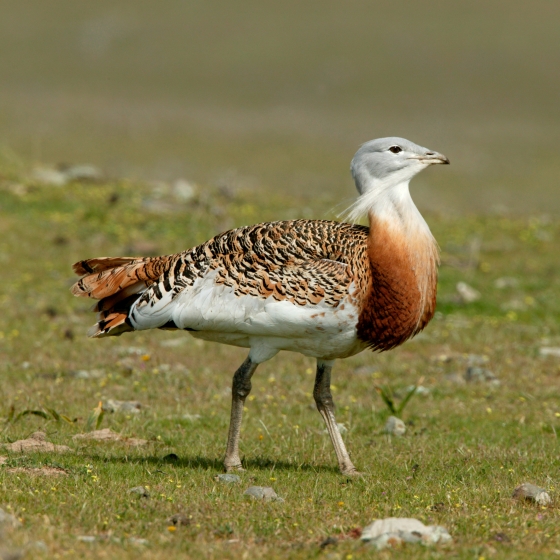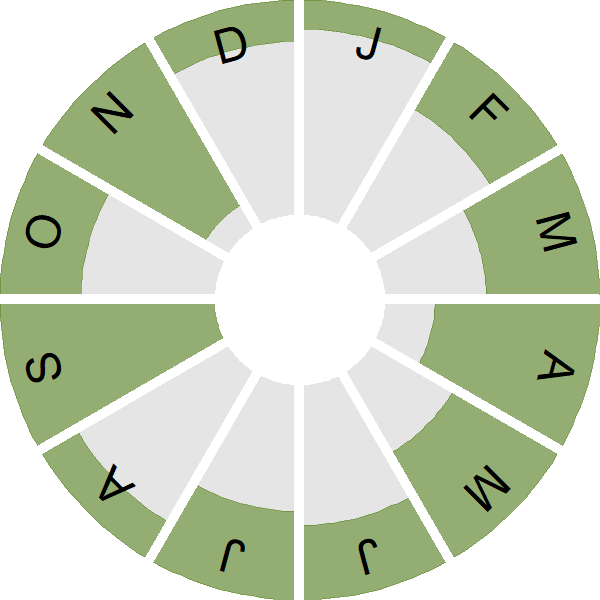Great Bustard

Introduction
Once a regular breeder, the Great Bustard declined to become an extremely rare visitor. Attempts to re-establish a population on Salisbury Plain were initiated in 2004.
Despite the association of this bird with farming, the disappearance of this striking species – which requires large open landscapes – coincided with the enclosure of fields with hedgerows. The last wild breeding individual was collected in 1832 in Suffolk.

Key Stats
Status and Trends
Conservation Status
Population Change
The Great Bustard bred in England from the late fifteenth to the early nineteenth century, but became extinct as a British breeding bird in 1832 (Waters & Waters 2005; Shrubb 2011). A reintroduction programme on Salisbury Plain began in 2004 and successful nesting first occurred in 2009 (Burnside et al. 2011). The project is ongoing and breeding numbers have increased slowly with 12 nesting females in 2019; a minimum of five of these nests were successful with at least ten young fledging (Eaton et al. 2021).
Distribution
Since 2004 Great Bustards have been reintroduced to Salisbury Plain, with breeding first confirmed in 2009.
Occupied 10-km squares in UK
or view it on Bird Atlas Mapstore.
or view it on Bird Atlas Mapstore.
European Distribution Map
Distribution Change
Change in occupied 10-km squares in the UK
or view it on Bird Atlas Mapstore.
or view it on Bird Atlas Mapstore.
Seasonality
This species has been too rarely reported to BirdTrack during 2011–22 to properly assess seasonality.
Movement
Britain & Ireland movement
European movements
EuroBirdPortal uses birdwatcher's records, such as those logged in BirdTrack to map the flows of birds as they arrive and depart Europe. See maps for this species here.
The Eurasian-African Migration Atlas shows movements of individual birds ringed or recovered in Europe. See maps for this species here.
Biology
Survival and Longevity
Survival is shown as the proportion of birds surviving from one year to the next and is derived from bird ringing data. It can also be used to estimate how long birds typically live.
Classification, names and codes
Classification and Codes
- Order: Otidiformes
- Family: Otididae
- Scientific name: Otis tarda
- Authority: Linnaeus, 1758
- BTO 2-letter code: US
- BTO 5-letter code: GREBU
- Euring code number: 4460
Alternate species names
- Catalan: pioc salvatge eurasiàtic
- Czech: drop velký
- Danish: Stortrappe
- Dutch: Grote Trap
- Estonian: suurtrapp
- Finnish: isotrappi
- French: Grande Outarde
- Gaelic: Coileach-Frangach
- German: Großtrappe
- Hungarian: túzok
- Icelandic: Trölldoðra
- Irish: Bustard Mór
- Italian: Otarda
- Latvian: liela siga
- Lithuanian: tikrasis einis
- Norwegian: Stortrappe
- Polish: drop (zwyczajny)
- Portuguese: abetarda
- Slovak: drop velký
- Slovenian: velika droplja
- Spanish: Avutarda euroasiática
- Swedish: stortrapp
- Welsh: Ceiliog y Waun
Research
Causes of Change and Solutions
Causes of change
All recent breeding attempts have resulted from the ongoing reintroduction programme on Salisbury Plain (Burnside et al. 2011). Although breeding numbers have been increasing slowly it remains too early to confirm whether this programme will be successful and will enable a self-sustaining population to survive in the longer term.

